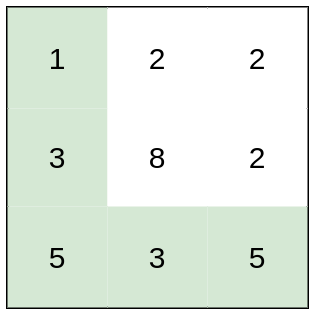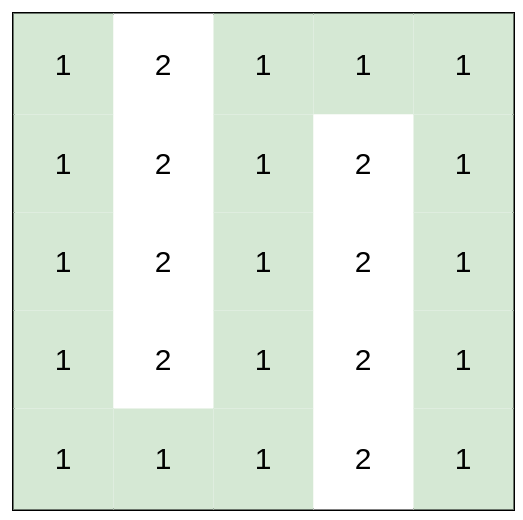- {x}
- All Valid Triplets That Can Represent a Country
- Largest Substring Between Two Equal Characters
- Lexicographically Smallest String After Applying Operations
- Best Team With No Conflicts
- Graph Connectivity With Threshold
- Design an Expression Tree With Evaluate Function
- Slowest Key
- Arithmetic Subarrays
- Path With Minimum Effort
- Rank Transform of a Matrix
- Percentage of Users Attended a Contest
- Add Two Polynomials Represented as Linked Lists
- Hopper Company Queries I
- Sort Array by Increasing Frequency
- Widest Vertical Area Between Two Points Containing No Points
- Count Substrings That Differ by One Character
- Number of Ways to Form a Target String Given a Dictionary
- Read More...

Path With Minimum Effort
You are a hiker preparing for an upcoming hike. You are given heights, a 2D array of size rows x columns, where heights[row][col] represents the height of cell (row, col). You are situated in the top-left cell, (0, 0), and you hope to travel to the bottom-right cell, (rows-1, columns-1) (i.e., 0-indexed). You can move up, down, left, or right, and you wish to find a route that requires the minimum effort.
A route's effort is the maximum absolute difference in heights between two consecutive cells of the route.
Return the minimum effort required to travel from the top-left cell to the bottom-right cell.
Example 1:

Input: heights = [[1,2,2],[3,8,2],[5,3,5]] Output: 2 Explanation: The route of [1,3,5,3,5] has a maximum absolute difference of 2 in consecutive cells. This is better than the route of [1,2,2,2,5], where the maximum absolute difference is 3.
Example 2:

Input: heights = [[1,2,3],[3,8,4],[5,3,5]] Output: 1 Explanation: The route of [1,2,3,4,5] has a maximum absolute difference of 1 in consecutive cells, which is better than route [1,3,5,3,5].
Example 3:

Input: heights = [[1,2,1,1,1],[1,2,1,2,1],[1,2,1,2,1],[1,2,1,2,1],[1,1,1,2,1]] Output: 0 Explanation: This route does not require any effort.
Constraints:
rows == heights.lengthcolumns == heights[i].length1 <= rows, columns <= 1001 <= heights[i][j] <= 106
1631. Path With Minimum Effort
This problem asks to find the minimum effort required to travel from the top-left cell (0, 0) to the bottom-right cell (rows-1, columns-1) in a 2D array of heights. The effort is defined as the maximum absolute difference in heights between consecutive cells along a path.
We can solve this using three main approaches: Union-Find, Binary Search + BFS, and Dijkstra's Algorithm with a Heap.
Solution 1: Union-Find
This approach cleverly transforms the problem into a minimum spanning tree problem.
Approach:
-
Create Edges: We represent the grid as a graph where each cell is a node. An edge connects adjacent cells, and its weight is the absolute difference in height between those cells. We create a list of all these edges.
-
Sort Edges: We sort the edges in ascending order of their weights.
-
Union-Find: We use a Union-Find data structure to track connected components. Initially, each cell is its own component.
-
Iterative Union: We iterate through the sorted edges. For each edge, we check if the two connected nodes belong to different components. If they do, we unite the components using the Union-Find's
unionoperation and record the current edge's weight. -
Termination: We stop when the top-left and bottom-right cells belong to the same component. The weight of the last edge added is the minimum effort required because we've connected the two cells using the smallest possible maximum edge weight.
Time Complexity: O(MN log(MN)), where M and N are the number of rows and columns respectively. This is dominated by the sorting of edges.
Space Complexity: O(M*N) to store the Union-Find data structure and the edges.
Code (Python):
class UnionFind:
def __init__(self, n):
self.p = list(range(n))
self.size = [1] * n
def find(self, x):
if self.p[x] != x:
self.p[x] = self.find(self.p[x])
return self.p[x]
def union(self, a, b):
pa, pb = self.find(a), self.find(b)
if pa == pb:
return False
if self.size[pa] > self.size[pb]:
self.p[pb] = pa
self.size[pa] += self.size[pb]
else:
self.p[pa] = pb
self.size[pb] += self.size[pa]
return True
def connected(self, a, b):
return self.find(a) == self.find(b)
class Solution:
def minimumEffortPath(self, heights: List[List[int]]) -> int:
m, n = len(heights), len(heights[0])
uf = UnionFind(m * n)
edges = []
for i in range(m):
for j in range(n):
for dx, dy in [(0, 1), (0, -1), (1, 0), (-1, 0)]:
x, y = i + dx, j + dy
if 0 <= x < m and 0 <= y < n:
edges.append((abs(heights[i][j] - heights[x][y]), i * n + j, x * n + y))
edges.sort()
for w, u, v in edges:
uf.union(u, v)
if uf.connected(0, m * n - 1):
return w
return 0
Solution 2: Binary Search + BFS
This approach leverages the monotonic nature of the problem.
Approach:
-
Binary Search: We perform a binary search on the possible range of maximum effort (0 to the maximum height difference in the grid).
-
BFS Check: For each potential maximum effort
midin the binary search, we use Breadth-First Search (BFS) to check if there exists a path from (0,0) to (rows-1, columns-1) where the maximum difference between adjacent cells is less than or equal tomid. -
Refinement: If a path exists for a given
mid, it means we might be able to find a path with even less effort, so we search in the lower half. Otherwise, we search in the upper half.
Time Complexity: O(MN log(H)), where H is the maximum height difference. The log(H) factor comes from the binary search. Each BFS takes O(MN) in the worst case.
Space Complexity: O(M*N) for the visited set in BFS.
Code (Python):
from collections import deque
class Solution:
def minimumEffortPath(self, heights: List[List[int]]) -> int:
def bfs(effort):
q = deque([(0, 0)])
visited = {(0, 0)}
while q:
r, c = q.popleft()
if r == len(heights) - 1 and c == len(heights[0]) - 1:
return True
for dr, dc in [(0, 1), (0, -1), (1, 0), (-1, 0)]:
nr, nc = r + dr, c + dc
if 0 <= nr < len(heights) and 0 <= nc < len(heights[0]) and \
abs(heights[nr][nc] - heights[r][c]) <= effort and (nr, nc) not in visited:
q.append((nr, nc))
visited.add((nr, nc))
return False
left, right = 0, 10**6 #Adjust range as needed based on constraints
ans = right
while left <= right:
mid = (left + right) // 2
if bfs(mid):
ans = mid
right = mid - 1
else:
left = mid + 1
return ans
Solution 3: Dijkstra's Algorithm with Heap
This is a more general shortest path algorithm suitable for weighted graphs.
Approach:
-
Graph Representation: Similar to the Union-Find approach, we represent the grid as a graph.
-
Dijkstra's: We use Dijkstra's algorithm to find the shortest path from (0,0) to (rows-1, columns-1). The weight of each edge is the absolute difference in height between adjacent cells. The "shortest path" in this context is the path with the minimum maximum edge weight.
-
Priority Queue (Heap): We use a min-heap (priority queue) to efficiently select the node with the minimum maximum edge weight encountered so far.
Time Complexity: O(MN log(MN)) due to the heap operations.
Space Complexity: O(M*N) for the distance array and heap.
Code (Python):
import heapq
class Solution:
def minimumEffortPath(self, heights: List[List[int]]) -> int:
m, n = len(heights), len(heights[0])
dist = [[float('inf')] * n for _ in range(m)]
dist[0][0] = 0
pq = [(0, 0, 0)] # (effort, row, col)
while pq:
d, r, c = heapq.heappop(pq)
if d > dist[r][c]:
continue
if r == m - 1 and c == n - 1:
return d
for dr, dc in [(0, 1), (0, -1), (1, 0), (-1, 0)]:
nr, nc = r + dr, c + dc
if 0 <= nr < m and 0 <= nc < n:
new_d = max(d, abs(heights[nr][nc] - heights[r][c]))
if new_d < dist[nr][nc]:
dist[nr][nc] = new_d
heapq.heappush(pq, (new_d, nr, nc))
return 0
All three solutions correctly solve the problem. The choice of which to use depends on your preference and understanding of graph algorithms. Union-Find might be slightly simpler conceptually, but Dijkstra's algorithm is a more broadly applicable shortest path algorithm. Binary Search + BFS offers a different approach and might perform better in some specific scenarios. Remember to handle edge cases and potential overflows appropriately.